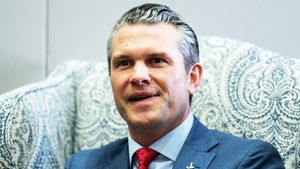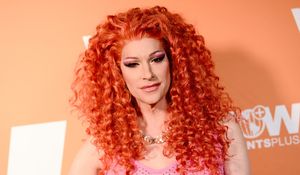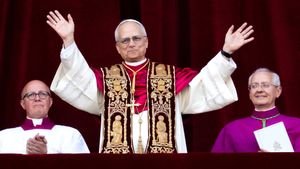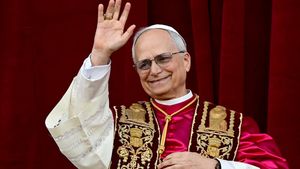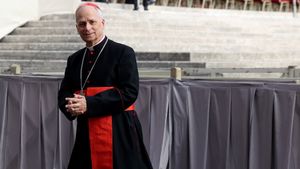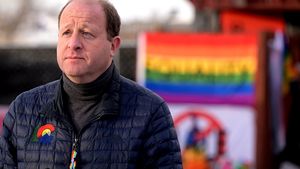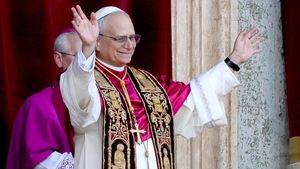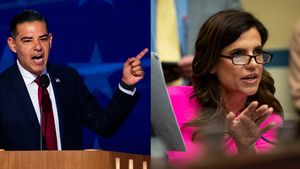"Make sure they know I have a sense of humor!" Rajendra "Raj" Roy tells me as we finish our discussion. When people ponder the Chief Film Curator for Museum of Modern Art, they probably don't envision a gay man who dances on tables and praises the hotness of Johnny Knoxville.
Since being appointed as chief curator in 2007, Roy has been instrumental in queering up the programming and selection of archived films. After discussing the recent Golden Globe nominations (He's a huge Carol fan), we quickly launched into an energetic discussion over the demands and expectations of his job (while I clocked the Y Tu Mama Tambien poster on his office wall) and what he hopes his legacy will be. MoMA Film recently celebrated its 80th anniversary, and Roy is optimistic about the future of cinema. "Everyone's a curator with Netflix, and Facebook, where they have a que of films they miss. I think the more eyeballs on screens, the better for all of us."
Out: In terms of picking up where your predecesor, Mary Lea Bandy, left off, where have you taken the film program in the past eight years?
Raj Roy: Mary Lea was here for so long and her contributions were such that they'll always be present, like the Film Preservation Center, the construction of which she oversaw. It's such a brick-and-mortar emblem that showcases her real commitment to film preservation.
When I started, I had a ton of enthusiasm and a ton of nervousness. What I knew for sure was that I had no experience as a film archivist. Glenn [Lowry], the director of MoMA, made it clear that they were open to a wide range of people and experiences. The fact that I had been nurtured through the indie film community, and the waves of '80s and '90s, was something MoMA recognized was critical to engage with. It wasn't that contemporary film was on their radar, but they knew the filmmakers that came up through that venue were necessary for the next stage of curating at MoMA.
I shelved my experience as a programmer, because I knew that the archive and collection was the thing that I couldn't fuck up. I did a lot of really intense work of informing myself and bringing people on board who were archivists. Eight years later, I'm proud to say that I'm now a marginally informed archivist. We've taken the collection into the 21st Century. Obviously, I couldn't let go of the programming side, so I was thrilled to also modernize how we present our films. That's why we have annual festivals, the Doc Fortnight Preservation fest, and the Contenders. We give people opportunities to make MoMA their cinematic home and, hopefully, discover films, filmmakers, and movements that they wouldn't have been aware of before.
What I wanted, especially with the Mike Nichols retrospective, was to remind people that film is a collaborative art form. I wanted to remind the field that the MoMA film department was founded via a relationship with Hollywood, lest they think we only show docs about Picasso. We are a department with strong ties to the industry.
We've noticed in the past few years more queer filmmakers being programmed, such as the recent Bruce LaBruce retrospective, which showcased a daring queer filmmaker whose films provoke as much as they entertain. Why did you choose him and his films, and what did this exhibition add to MOMA?
Bruce is someone who was critical to my evolution as a film curator. I started out in New York at the Mix Festival as an intern, and one of my first assignments was organizing the New York premiere of Hustler White. No Skin Off My Ass was formative for me, and that's when I really fell in love with experimental queer cinema. I got to know Bruce early on that way, and Hustler White was an odd moment because it was way more mainstream. We followed it up by doing a premiere for a skin flick, which was, in a way, back to his origins. Next step was to see him go through that transition and celebrate with him. We took scary steps together, and had fun with it, and we were successful at it. He was always someone I knew I'd want to work with.
RELATED | Bruce LaBruce's Punk Porno Provocations at MoMA
He started with experimental -- going through a Hollywoodish experience -- into the porn industry, and then provocateur, and then avant-garde pure cinema in a way. When we did this show on this porn provocateur, the response was totally embracing. Everyone got the narrative we were putting forward. It was a risk for the museum. Some press could have been really nasty because someone was being so aggressively sexual in their film, but they said it was liberating for MoMA. We were both a little shocked. It worked more than we intended or expected.
But we've certainly done and been involved in queer programming before. The conversation became much less about queer cinema in its own right, and how these films and artists could function as part of the canon and DNA of MoMA.
In the '90s, a group of filmmakers were labeled New Queer Cinema (Todd Haynes, Gus Van Sant, Gregg Araki) but always chafed at the title. Now do you see any trends or do you think there's a need for filmmakers to tackle queer themes?
Part of the dialogue around Carol--and director Todd Haynes, one of the originals--has been that it's so mainstream that it's not even queer anymore. That's not a new criticism, but I find it bizarre. The queerness of filmmaking is in the picture itself. One of the best observations about Carol was from Justin Vivian Bond, who went off on the coloring in Carol, how authentic and essential it was in making Cate Blanchett's character absolutely real. That's the queer element. You could say just costume design, but the tonality in the fingernail polish, that's queer filmmaking. Cate Blanchett and Rooney Mara falling in love is not a stretch, but I don't hear that ring true as a criticism as we've gone past something. That's not what queer cinema is about.

It's been 10 years since Brokeback Mountain. Milestones are important to recognize, but even at the time, as someone established as Ang Lee was, it was important at the time of following the trajectory as people affiliated with new queer cinema. You wouldn't have Transparent if there hadn't been New Queer Cinema in the '90s. If you're only looking at cinematic releases, it's going to seem like it fizzled and went in such a mainstream direction, but that's a limited view.
There used to be such an irreconcilable difference between high/low cinema, but now I feel people can love the movie Burlesque and also want to catch a Godard film later that day. Does MoMA make a difference between high/low culture when it comes to movies?
No, and actually the film, architecture, and design departments are the most liberated departments at MoMA in the high/low debate. We've always taken the stance that it's a false dichotomy and there are films that are important and unimportant, relevant and irrelevant, in both categories. For exmaple, there's nothing lower than the films of Andy Warhol. Technically, they suck, they're narratively endless, and the acting is atrocious. Of course, Andy would endorse B films, because B movies are great. That wasn't something I had to argue when I started here.
There shouldn't be a hierarchy based on means of production or some established sense of what's good or bad. We're not saying everything deserves scrutiny. It makes complete sense that the Jackass phenomenon was the evolution of slapstick comedy. Why would MoMA be interested in Jackass? It's not because Johnny Knoxville is the hottest guy in the world, but because they're carrying on the tradition of propelling physical comedy, which has been for changing for over a hundred years. They're the best at it right now.
MoMA has an amazing archive, truly second to none. Are they still finding and discovering things? What does it take to be added to the MoMA film collection?
We are adding new titles. There's always scrutiny as to what gets in with debates among curators. We have to add to a narrative of cinema history, not just include every story. When we decide to embrace a new movement or director, hopefully we can make investment to go back in history and fill in gaps to tell the richest story possible.
There are amazing opportunities for discovery within the collections on our shelves. In some cases, we don't have equal knowledge of everything. Like the Burt Williams discovery. We discovered an unfinished movie from 1913 while researching, and we ended up having the unedited footage of a feature film with an all African-American cast. It's the earliest example of a feature with an all-black cast. While piecing it together, we became aware of the incredible relevance and interest to film historians, and also the cultural significance. There was no image of the black middle class over a hundred years ago. Black people were cast as people to be feared. We can postulate that it was never finished and released because how do you show this prosperous black family at the same time as when a black guy rapes a woman in Birth of a Nation? With this, we crack open what people are thinking now.
Which films have influenced you?
That's literally the hardest question because it depends on the day and mood I'm in, and where my thinking goes. David Lynch was someone very formative for me at an early stage. Experimental film propelled me into the business, and it got me in relationships with artists that continue to this day. That's why I do this. Every day I work directly with amazing artists, and it's the biggest privilege. My father raised me watching Marx Brothers movies. Having that background in wit--real true comedic wit--influenced me as well. It really gave me an appreciation for classic cinema.
Any gay or queer-themed films specifically?
No Skin Off My Ass absolutely was one. I loved the outsiderness of it. Since it was the '80s and the AIDS-era, activism wasn't a question. In that moment there weren't any real distinctions between the experiences of a queer person of color and a white gay man. And any film that provided a little bit of outsiderness affected me. I'm really into Dee Rees. Pariahwas a big eye opener. The way [Aziz Ansari's Netflix series] Master of None takes race on? I mean, the best friend is a black lesbian, without an explanation--that's awesome. That's where we intend to be. Someone opened a door.
Queer representation is something I look for and happily have come to expect in less filtered ways. Some of my brethren complain about queer films not being sequestered in gay-enough worlds, but come on. Sure, I miss the thrill of being secretly gay, a fetish we had to have because we had no choice, but the fact that queer images aren't solely sequestered in queer stories anymore, that kind of had to be what we were hoping for.
What do you hope will be your legacy regarding the film program?
I definitely want to be seen as someone who makes every effort to make sure the collection is safeguarded and nurtured so it's possible for future generations to be inspired and awed by cinema history. We're right in the middle of this transition from film to digital, and never in a million years did I think I'd be the guy in charge of film archiving through a transition as profound as the move from silent to sound. It's a major technological shift fraught with peril and risk, especially to history. In evolution, it requires a lot of faith in tech teams. You can't put a hard drive on shelf. I think we are making the right steps. In short, I hope people think that I didn't fuck it up, and I helped figure out what to do next.
Randome question that we like to ask from time to time: What is your spirit animal?
I'm a Leo, so Aslan or whatever.
If you could have dinner with anyone, living or dead, who would it be?
I'd want to be transported back to Hollywood in 1970s with Robert Evans, so I could be apart of what seems like the greatest generation in movies.
Find out more about MoMA's film program here.











